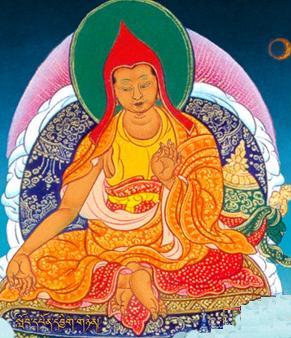Treasury of Abhidharma: Difference between revisions
m (→Indian) |
m (→Tibetan) |
||
| Line 37: | Line 37: | ||
*[[Chim Jampé Yang]], ''[[Ornament of Abhidharma]]'' (མངོན་པའི་རྒྱན་, ''mngon pa'i rgyan'') | *[[Chim Jampé Yang]], ''[[Ornament of Abhidharma]]'' (མངོན་པའི་རྒྱན་, ''mngon pa'i rgyan'') | ||
*[[Chim Lozang Drakpa]], ''[[An Ocean of Excellent Explanations Clarifying the Abhidharma Kosha]] ([[Wyl.]] '' | *[[Chim Lozang Drakpa]], ''[[An Ocean of Excellent Explanations Clarifying the Abhidharma Kosha]]'' ([[Wyl.]] ''chos mngon pa gsal byed legs par bshad pa'i rgya mtsho'') | ||
*[[Gendün Drup]] (1391–1474) ''Illuminating the Path to Liberation'' (ཐར་ལམ་གསལ་བྱེད་, ''thar lam gsal byed'') | *[[Gendün Drup]] (1391–1474) ''Illuminating the Path to Liberation'' (ཐར་ལམ་གསལ་བྱེད་, ''thar lam gsal byed'') | ||
*[[Rongtön Sheja Kunrig]], ''Thoroughly Illuminating What Can be Known'' (ཤེས་བྱ་རབ་གསལ་, ''shes bya rab gsal'') | *[[Rongtön Sheja Kunrig]], ''Thoroughly Illuminating What Can be Known'' (ཤེས་བྱ་རབ་གསལ་, ''shes bya rab gsal'') | ||
Revision as of 10:06, 29 May 2016

The Treasury of Abhidharma (Skt. Abhidharmakośa; Tib. ཆོས་མངོན་པའི་མཛོད་, Ngönpa Dzö; Wyl. chos mngon pa'i mdzod) was composed by Vasubandhu, one of the 'Six Ornaments', the greatest Buddhist authorities of Ancient India. Abhidharmakosha is a complete and systematic account of the Abhidharma, and is the peak of scholarship in the Fundamental Vehicle. If this text presents the different topics from the Vaibhashika point of view, Vasubandhu also wrote an autocommentary, the Auto-Commentary on the Treasury of Abhidharma (Skt. Abhidharmakośa-Bhāṣya), which is based on the Sautrantika view.
The Abhidharmakosha and the auto-commentary were translated in the 8th century by Kawa Paltsek and the Indian pandita Jinamitra.It is included among the so-called "Thirteen great texts", which form the core of the curriculum in most shedras and on which Khenpo Shenga provided commentaries.
Outline
The text is divided into eight topics:
- The elements (Skt. dhātu)
- The faculties (Skt. indriya)
- The world (Skt. loka)
- Actions (Skt. karma)
- 'Subtle developers' (Skt. anuśaya) (i.e. negative emotions)
- The path and the individual (Skt. mārgaprahāṇa)
- Wisdom (Skt. jñāna)
- Meditative equipoise (Skt. samāpatti)
Commentaries
| This section contains Tibetan script. Without proper Tibetan rendering support configured, you may see other symbols instead of Tibetan script. |
Indian
Including Vasubandhu's own commentary, there are nine commentaries which have been translated into Tibetan and found their way into the Tengyur. The two most renowned are those by Rājaputra Yaśomitra and Pūrṇavardhana, of which Yaśomitra's is considered, by Chim Jampé Yang, the best.
- Vasubandhu, Abhidharma Kośa(ཆོས་མངོན་པའི་མཛོད་ཀྱི་ཚིག་ལེའུར་བྱས་པ༎།, chos mngon pa'i mdzod kyi tshig le'ur byas pa)
- English translation: Abhidharmakosabhasyam of Vasubandhu, translated by Leo M. Pruden, Asian Humanities Press, Berkeley 1990 (Translated into English from the French translation of Louis de La Vallé Poussin, L'Abhidharmakośa de Vasubandhu, Institut belge des hautes études chinoises, Bruxelles, 1971)
- French Translation: Louis de La Vallé Poussin, L'Abhidharmakośa de Vasubandhu, available for free download from Archive.org
- Yashomitra, Abhidharmakośaṭīkā (ཆོས་མངོན་པའི་མཛོད་ཀྱི་འགྲེལ་བཤད།, chos mngon pa'i mdzod kyi 'grel bshad (don gsal ba))
- Saṅgabhadra, Abhidharmakosa Sastra Karika Bhasya(ཆོས་མངོན་པ་མཛོད་ཀྱི་བསྟན་བཅོས་ཀྱི་ཚིག་ལེའུར་བྱས་པའི་རྣམ་པར་བཤད་པ།, chos mngon pa mdzod kyi bstan bcos kyi tshig le'ur byas pa'i rnam par bshad pa)
- Pūrṇavardhana, Abhidharmakosa Tika Laksananusarini(ཆོས་མངོན་པ་མཛོད་ཀྱི་འགྲེལ་བཤད་མཚན་ཉིད་ཀྱི་རྗེས་སུ་འབྲང་བ།, chos mngon pa mdzod kyi 'grel bshad mtshan nyid kyi rjes su 'brang ba)
- Śamathadeva , Abhidharmakosa Tikopayika(ཆོས་མངོན་པའི་མཛོད་ཀྱི་འགྲེལ་བཤད་ཉེ་བར་མཁོ་བ།, chos mngon pa'i mdzod kyi 'grel bshad nye bar mkho ba)
- Dignaga, Abhidharmakosa Vrtti Marmadipa(ཆོས་མངོན་པའི་མཛོད་ཀྱི་འགྲེལ་པ་གནད་ཀྱི་སྒྲོན་མ།, chos mngon pa'i mdzod kyi 'grel pa gnad kyi sgron ma)
- Pūrṇavardhana, Abhidharmakosa Tika Laksananusarini (2nd commentary, but with same name as first)(ཆོས་མངོན་པ་མཛོད་ཀྱི་འགྲེལ་བཤད་མཚན་ཉིད་ཀྱི་རྗེས་སུ་འབྲང་བ།, chos mngon pa mdzod kyi 'grel bshad mtshan nyid kyi rjes su 'brang ba)
- Unknown author, Abhidharmavatara tika(ཆོས་མངོན་པ་ལ་འཇུག་པ་རྒྱ་ཆེར་འགྲེལ་པ་སྙིང་པོ་ཀུན་ལས་བཏུས་༎, chos mngon pa la 'jug pa rgya cher 'grel pa snying po kun las btus )
- Sthiramati, Abhidharmavatara(རབ་ཏུ་བྱེད་པ་ཆོས་མངོན་པ་ལ་འཇུག་པ།, rab tu byed pa chos mngon pa la 'jug pa)
Tibetan
The following are among the best known Tibetan commentaries on the Abhidharmakosha:
- Chim Jampé Yang, Ornament of Abhidharma (མངོན་པའི་རྒྱན་, mngon pa'i rgyan)
- Chim Lozang Drakpa, An Ocean of Excellent Explanations Clarifying the Abhidharma Kosha (Wyl. chos mngon pa gsal byed legs par bshad pa'i rgya mtsho)
- Gendün Drup (1391–1474) Illuminating the Path to Liberation (ཐར་ལམ་གསལ་བྱེད་, thar lam gsal byed)
- Rongtön Sheja Kunrig, Thoroughly Illuminating What Can be Known (ཤེས་བྱ་རབ་གསལ་, shes bya rab gsal)
- Mipham Rinpoche, རིན་པོ་ཆེའི་དོ་ཤལ་བློ་གསལ་དགྱེས་པའི་མགུལ་རྒྱན་, rin po che'i do shal blo gsal dgyes pa'i mgul rgyan
- Jamyang Loter Wangpo, A Lamp Illuminating Vasubandhu's Intention (དབྱིག་གཉེན་དགོངས་པ་གསལ་བའི་སྒྲོན་མེ་, dbyig gnyen dgongs pa gsal ba'i sgron me)
- Khenpo Shenga, A Mirror for What Can be Known (ཤེས་བྱའི་མེ་ལོང་, shes bya'i me long)
Further Reading
- James Duerlinger, Indian Buddhist theories of persons: Vasubandhu's "Refutation of the theory of a self", Routledge, 2003
